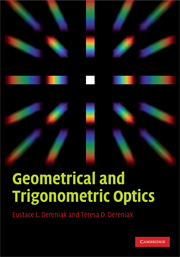Book contents
- Frontmatter
- Contents
- Preface
- 1 Light propagation
- 2 Reflections and refractions at optical surfaces
- 3 Image formation
- 4 Mirrors and prisms
- 5 Curved optical surfaces
- 6 Thin lenses
- 7 Thick lenses
- 8 Mirrors
- 9 Optical apertures
- 10 Paraxial ray tracing
- 11 Aberrations in optical systems
- 12 Real ray tracing
- Appendix A Linear prism dispersion design
- Appendix B Linear mixing model
- Appendix C Nature's optical phenomena
- Appendix D Nomenclature for equations
- Appendix E Fundamental physical constants and trigonometric identities
- Glossary
- Index
- References
12 - Real ray tracing
Published online by Cambridge University Press: 06 July 2010
- Frontmatter
- Contents
- Preface
- 1 Light propagation
- 2 Reflections and refractions at optical surfaces
- 3 Image formation
- 4 Mirrors and prisms
- 5 Curved optical surfaces
- 6 Thin lenses
- 7 Thick lenses
- 8 Mirrors
- 9 Optical apertures
- 10 Paraxial ray tracing
- 11 Aberrations in optical systems
- 12 Real ray tracing
- Appendix A Linear prism dispersion design
- Appendix B Linear mixing model
- Appendix C Nature's optical phenomena
- Appendix D Nomenclature for equations
- Appendix E Fundamental physical constants and trigonometric identities
- Glossary
- Index
- References
Summary
Approach
The act of image formation in our present understanding consists of reformatting diverging wavefronts from a source (object) to converging spherical wavefronts moving toward image points in the image plane. The transfer of wavefronts through an optical system can be done most easily, as has been accomplished so far, by the use of ray tracing. The tracing of rays through an optical system is determined purely by geometrical considerations and trigonometry. The assumptions made in ray tracing through an optical system are:
(1) Rays travel at a constant velocity in homogeneous media.
(2) Rays travel in straight lines.
(3) Rays follow Snell's law at the interface between media.
(4) At an interface, the reflected and refracted rays lie in the plane of incidence.
(5) Object and image surfaces are opaque.
Ray tracing through an optical system is best accomplished by a moving coordinate system using simple geometrical considerations and trigonometric functions, totally ignoring diffraction effects.
Thus far, only paraxial rays have been used to find the image location, size and brightness. The small angle approximation describes the optical system to first order; however, for object points at large distances from the optical axis, corresponding image points are clearly aberrated and not correctly predicted by paraxial ray tracing. Real ray tracing uses vectors starting from a point with direction cosines for the ray in each space (segment) as it is traced from the object point to the image point.
- Type
- Chapter
- Information
- Geometrical and Trigonometric Optics , pp. 328 - 346Publisher: Cambridge University PressPrint publication year: 2008



